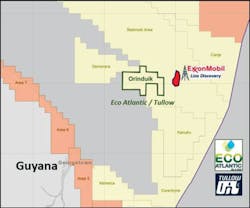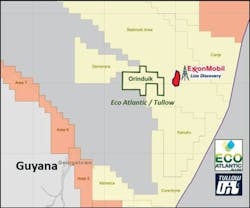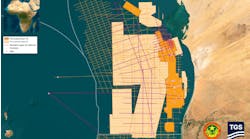Jessica Tippee
Assistant Editor
The United States Geological Survey ranks Guyana-Suriname as the world’s second-most prospective, underexplored offshore basin, with an estimated 13.6 Bbbl of oil and 32 tcf of natural gas yet to be discovered. While current commercial production in the region stems from onshore Suriname fields, the rationale for offshore exploration was fueled by the theory that the basin was formed due to continental drift of the Equatorial Atlantic region. If recent exploration success proves to be commercial,Guyana will have even more to celebrate along with the 50th anniversary of its independence from the UK.
In May 2015, ExxonMobil announced it made a significant oil discovery with the Liza-1 exploration well on the Stabroek block about 120 mi (193 km) offshore in the Guyana-Suriname basin. It encountered more than 295 ft (90 m) of high-quality oil-bearing sandstone reservoirs. The Transocean drillshipDeepwater Champion drilled the well to an Upper Cretaceous fan play at 17,825 ft (5,433 m) in 5,719 ft (1,743 m) of water.
Operator Esso Exploration & Production Guyana Ltd., an ExxonMobil affiliate, holds 45% interest. Its partners are Hess Guyana Exploration Ltd. with 30% interest and CNOOC Nexen Petroleum Guyana Ltd. with 25% interest.
Liza was the first well drilled on the 6.6-million acre (26,800-sq km) Stabroek block. Since the 1970s, 22 wells drilled on the coastal shelf outside the southern boundaries of the block had all proved noncommercial. In 2012, CGX Energy’s Eagle-1 well drilled on the Corentyne petroleum prospecting license failed to find commercial hydrocarbons. That same year Repsol Exploracion terminated operations on the high-pressure/high-temperature Jaguar-1 well on the Georgetown petroleum prospecting license. According to partner CGX Energy, the well was due to be plugged at a depth of 15,997 ft (4,876 m) without reaching the primary objective in the Late Cretaceous geologic zone. The decision was taken after the well reached a point where pressure design limits for safe operations prevented further drilling. Despite not reaching the main target, light oil was recovered from two Late Cretaceous turbidite sands.
Until Liza-1, the only material discovery in the basin was Shell’s Zaedyus oil find off French Guiana in 2011. The Zaedyus discovery well intersected 236 ft (72 m) of net oil pay in two turbidite fans; however, two appraisal wells had disappointing, noncommercial results. According to analyst Wood Mackenzie, the Zaedyus appraisal demonstrates the risks around discovery volumes in the basin, specifically regarding seal integrity and hydrocarbon migration.
ExxonMobil is reportedly moving Liza into the pre-front-end engineering and design phase. Despite low oil prices, analysts such as Douglas-Westwood agree a fasttrack development, while capital-intensive, could provide large potential returns on investment. Analysis from research and consulting firm GlobalData suggests that an FPSO-based development at the field would return above 19.8% in a flat-oil-price scenario of $61.68/bbl. Anna Belova, GlobalData’s senior upstream analyst, said: “While there is risk around the assumed initial production rates of 20,000/d per development well, there is upside in additional cost efficiencies as low oil prices have been accompanied with decreases in FPSO leasing terms and drillship day rates.
“Additionally, the 201 MMbbl recoverable reserves estimate falls on the lower end of 700 MMbbl of oil reserve suggestions from Guyana’s minister of governance. Higher reserve scenarios, recovering upward of 600 MMbbl, have an internal rate of return of over 35% while capturing the economies of scale realized with FPSO developments.”
Although cost metrics for the Liza scenarios are consistent with other projects featuring a leased FPSO, economic metrics are more favorable than global averages, the analyst claims, due to the competitiveness of the Guyanese production-sharing agreement regime.
Matthew Jurecky, GlobalData’s head of Oil & Gas Research and Consulting, added: “The Liza project will also be well-placed to benefit from any uplift in oil prices post-development. Its commercial success could redefine the basin as a global deepwater production player.”
Earlier this year the partners completed a 6,654-sq mi (17,000-sq km) 3D seismic survey to evaluate the full resource potential of the acreage. In addition, the operator has contracted Fugro to acquire, process, and analyze high-quality AUV multibeam bathymetry, side scan sonar and sub-bottom profiler data, as well as environmental and geological/geotechnical samples, providing seabed and shallow sub-seabed information to support the initial field development. The survey will cover an area of approximately 247 sq mi (640 sq km) in depths reaching 9,187 ft (2,800 m). In February, ExxonMobil began a multi-well exploration and appraisal campaign with the Liza #2 appraisal well.
Other operators are increasing their exploration activities offshore Guyana. In January, the Minister of Natural Resources Raphael Trotman signed a petroleum prospecting license and production-sharing agreement with the joint venture team of Tullow Guyana BV and Eco (Atlantic) Guyana Inc. The license covers the Orinduik block, a concession of 695 sq mi (1,801 sq km) in the Guyana-Suriname basin. The agreement calls for a work program involving a geological and geophysical evaluation which will include a 3D seismic acquisition, all within the initial 10-year period of the license. Tullow will hold the operatorship and 60% working interest, with Eco Atlantic holding the remaining 40%. Tullow also is assessing prospectivity in the Repsol-operated Kanuku license, and the partners have requested an 18-month extension to facilitate acquisition of a new 3D seismic survey.




